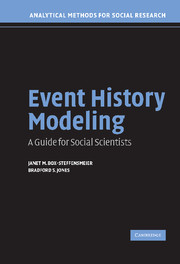Book contents
- Frontmatter
- Contents
- List of Figures
- List of Tables
- Preface
- 1 Event History and Social Science
- 2 The Logic of Event History Analysis
- 3 Parametric Models for Single-Spell Duration Data
- 4 The Cox Proportional Hazards Model
- 5 Models for Discrete Data
- 6 Issues in Model Selection
- 7 Inclusion of Time-Varying Covariates
- 8 Diagnostic Methods for the Event History Model
- 9 Some Modeling Strategies for Unobserved Heterogeneity
- 10 Models for Multiple Events
- 11 The Social Sciences and Event History
- Appendix: Software for Event History Analysis
- References
- Index
Appendix: Software for Event History Analysis
Published online by Cambridge University Press: 05 September 2012
- Frontmatter
- Contents
- List of Figures
- List of Tables
- Preface
- 1 Event History and Social Science
- 2 The Logic of Event History Analysis
- 3 Parametric Models for Single-Spell Duration Data
- 4 The Cox Proportional Hazards Model
- 5 Models for Discrete Data
- 6 Issues in Model Selection
- 7 Inclusion of Time-Varying Covariates
- 8 Diagnostic Methods for the Event History Model
- 9 Some Modeling Strategies for Unobserved Heterogeneity
- 10 Models for Multiple Events
- 11 The Social Sciences and Event History
- Appendix: Software for Event History Analysis
- References
- Index
Summary
There are a wide variety of statistical software packages available for event history analysis. We briefly discuss some of these packages. In this book, the software package Stata was primarily used to estimate most of the models. For some illustrations, the software package S-Plus was utilized. The data sets and code used to estimate most of the models in this book are available via Brad Jones's Web site:
http://www.u.arizona.edu/∼ bsjones/eventhistory.html.
Stata (http://www.stata.com/)
The software package Stata (Stata Corporation, College Station, TX) can be used to estimate a wide variety of parametric models as well as extensions for the Cox proportional hazards model. Moreover, the package has a suite of diagnostics for both parametric and nonparametric models. Stata and its user community have continued to greatly expand the functionality of the program for event history users. One notable strength of Stata is its ability to handle complicated event history data structures. Cleves, Gould, and Gutierrez (2002) provide in-depth coverage of Stata's functions for event history analysis.
S-Plus (http://www.insightful.com/products/splus/default.asp)
S-Plus (MathSoft, Inc., Seattle, WA) provides excellent interactive estimation tools for event history modeling. The event history functions were written primarily by Terry Therneau, Head of Biostatistics at Mayo Clinic. It is easily extended to incorporate user-written code. Further, S-Plus is known for its emphasis on graphics, which is particularly important in an event history context. The GUI (Graphical User Interface) is one of the main advantages of S-Plus over R, the open-source equivalent of S-Plus.
- Type
- Chapter
- Information
- Event History ModelingA Guide for Social Scientists, pp. 199 - 200Publisher: Cambridge University PressPrint publication year: 2004

